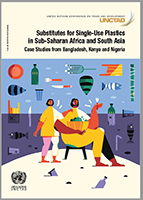This paper assesses the economic and technical feasibility of the production, deployment and scale-up of substitutes for single-use plastics (SUPs) in selected countries in sub-Saharan Africa and South Asia.
A shift towards SUP substitutes could be one means of addressing the growing environmental and health challenges, including marine pollution, posed by the mismanagement of plastic waste in these regions.
On the basis of this assessment and an evaluation of a range of potential substitute materials from a life-cycle perspective, the paper proposes specific plastic substitute options that could be considered for Bangladesh in South Asia and for Nigeria and Kenya in sub-Saharan Africa.
These countries have been selected on the basis of a number of criteria including coastal locations, problems and challenges faced with regard to SUP pollution, a certain degree of manufacturing capacity, and both awareness of and initiatives to address plastic pollution among government and civil society groups. The potential for these countries to harness trade-related opportunities in these feedstocks and end-use products is also explored.
Chapter 1 examines environmental and health challenges arising from SUPs in sub-Saharan Africa and South Asia, highlighting particular examples from Sustainable Manufacturing and Environmental Pollution (SMEP) target countries (UNCTAD, n.d.), including the paper’s three focus countries: Bangladesh, Kenya and Nigeria.
It builds on and incorporates research and experiences developed under UNCTAD’s Programme on Oceans Economy and Fisheries. It identifies some problematic SUPs, on the basis of a global survey of beach litter in certain countries in South Asia and sub-Saharan Africa. It also reviews gaps and challenges related to waste management and recycling that heighten the SUP pollution problem in these countries.
Chapter 2 sets out and clarifies some key terms, definitions and concepts for SUPs and their substitutes – both polymer- and non-polymer-based materials. It also discusses issues related to standards and labelling practices with regard to packaging, including composition and end-of-life attributes.
Chapter 3 examines the reasons behind the widespread utilization of plastics for specific end uses. It also lays out a methodology for the identification of non-polymer-based natural feedstock materials that could be used to manufacture SUP replacements for specific end-use products in the three case-study countries.
Chapter 4 applies life-cycle assessment (LCA) tools to assess and compares the environmental sustainability performance of the various feedstock options identified in chapter 3. Information regarding sustainability performance was derived through the following tasks: a review of LCA studies; country-specific screening LCAs for grocery bags in Bangladesh, Kenya and Nigeria; and countryspecific screening for all selected product categories in Nigeria, to assess their performance in multiple environmental impact categories.
Chapter 5 analyses the techno-economic dimension of the plastic substitute materials based on the LCA assessments of the three countries in chapter 4. The analysis aims to assess the availability of the identified feedstocks in the respective markets, the technical infrastructure and capability available to produce these products, and their economic viability.
Chapter 6 examines the trade flows and the trade policy landscape of all SMEP countries, and the South Asia and sub-Saharan Africa regions more broadly, for plastic as well as selected non-plastic feedstocks and end-use products. It discusses the potential for harnessing opportunities in trade. It also reviews the most-favoured nation (MFN) import duties applied to these products in the three case-study countries as well as prevalent duties applied in the context of selected bilateral and regional trade agreements.
Chapter 7 examines the domestic regulatory landscape to address prevalent SUPs in sub-Saharan Africa and South Asia, and notes key challenges and particular gaps that could be addressed.
Chapter 8 outlines broad conclusions and policy options based on the findings in this report. They address the following themes: (i) selecting the right SUP substitutes; (ii) building an effective ecosystem and enabling regulatory environment to address SUP pollution and encourage a circular economy; and (iii) enabling developing and least developed countries (LDCs) to tap into trade opportunities arising from enhanced manufacturing and production of plastic substitutes.
The study is part of the Sustainable Manufacturing and Environmental Pollution (SMEP) programme, funded by the Foreign, Commonwealth and Development Office of the United Kingdom.


